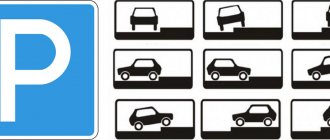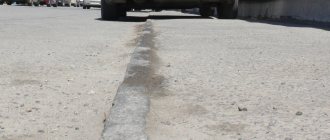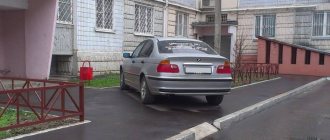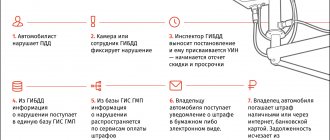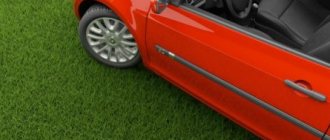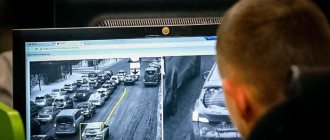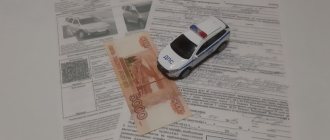Any citizen who gets behind the wheel of a car must comply with the Traffic Rules and other regulations governing the movement of vehicles, as well as their parking.
Parking on the lawn is one of the most controversial violations. Federal law does not establish penalties for this action. The legality of holding a car owner liable is determined based on local laws and regulations.
What is considered a lawn when parking a vehicle?
A lawn is an area of land planted with grass. It serves as an element of landscaping. There are lawns in parks and squares where they are intended for walking. In squares and parks, lawns are not always separated by curbstones. But in these cases they do not have a direct connection with the highway.
Considering the fact that the lawn is not part of the road and is usually separated from it by a curb, parking a car in such a place is a violation of the Traffic Rules, for which a fine is imposed for parking on the lawn.
To be fair, it should be noted that the concept of “lawn” is not in the Code of Administrative Offenses and the Traffic Regulations. Hence many controversial issues regarding fines. However, in regional laws you can find different designations for this territory. Among other things, they contain provisions where the authorities demand payment from the culprit for damage to the lawn.
What the law says
In the traffic rules, the concept of lawn is mentioned only once. It is said that a lawn is a green area that separates the sidewalk and the driveway. Regional documents may have different definitions of the concept of lawn. In any case, the lawn is an element of urban improvement, and not part of the road. Damage to green spaces is punishable by a fine, the amount of which also depends on the region and city.
In the Moscow region, a lawn is considered to be an artificially created grassy area (with real or artificial grass). That is, one that is specially made by people. A vacant lot overgrown with weeds is not considered a lawn. At the same time, there may be elements of park structures, trees, flower beds, etc. on the lawn. Also, a football field and other sports grounds are considered a lawn area.
What is the fine for parking on the lawn?
Next, we will consider the amount of administrative punishment in 2021 for individuals, officials and legal entities in federal cities of the Russian Federation, and then in other regions.
Administrative responsibility in Moscow
In Moscow, a regulatory body such as the Traffic Management Center, operating under the city government, can issue a fine.
For such a violation on the basis of Article 8.25 of Moscow Law No. 45 of November 21, 2007:
- an individual will be fined 5,000 rubles;
- officials will have to pay 30,000 rubles;
- and for organizations – 300,000 rubles.
Violation of parking rules in St. Petersburg
In the Northern capital, in accordance with Article 32 of St. Petersburg Law No. 273-70 of May 31, 2010, the following fines are imposed for parking on the lawn:
- for individuals: 3-5 thousand rubles;
- for officials: 5-40 thousand rubles;
- for legal entities: 150-500 thousand rubles.
How much will you have to pay for parking in a green zone in other regions?
In other Russian regions, the amount of fines is determined by local regulations. If there is no such law in the subject, then the norm specified in the Code of Administrative Offenses (Article 12.19 of the Code of Administrative Offenses) is adopted - 500 rubles.
How to legally park on the lawn and not have to pay anything for it?
How to legally park on the lawn and not have to pay anything for it?
In short, no way.
Now cunning motorists can close the article, and we will continue the conversation with sane people who are tired of arbitrariness in their yards. And at the end of the article we will learn how to effectively combat this arbitrariness.
I think there is no need to explain why parking on lawns (or rather, not on lawns) is bad. But if anyone doesn't understand, here are the main reasons:
1) Dirt.
Machines with wheels destroy the turf that strengthens the mail, turning the ground into a dirty mess. By the way, one of the frequent arguments from motorists is: “Where do you see the lawn here?” So, the lawn could grow if cars did not drive across it every day.
In itself, such land plowed by wheels does not look aesthetically pleasing, but that’s not the only thing. The dried mud is blown away by the wind. You bring it home every day on your shoes. Residents of the 1st-3rd floors wipe it off the windowsill once a week.
In fact, this behavior of a motorist is equivalent to a situation in which he would come to your house and throw, say, a cigarette butt on the floor. Do you enjoy cleaning up after someone? No to me.
2) Noise.
The car itself is a noisy thing. This is especially noticeable when cars start starting up one after another under the windows at five or six in the morning. Parking lots should be located away from residential buildings.
3) Aesthetics.
Agree, seeing a yard filled with haphazardly parked cars is a dubious pleasure.
Now that motorists (the part of them that does not understand or does not want to admit the above truth) have felt a burning sensation just below their backs, it is worth answering their most common argument in favor of parking on lawns. So:
1) Where should I park? Wherever you want, where it is allowed by the rules. Parking on lawns is prohibited.
2) I have nowhere to park my car, what should I do if there are no places nearby where I can park it legally? You should have thought about this when you bought a car. If there is no way to park it, sell it. I really want to buy a grand piano for my home, but it won’t fit in my apartment. Agree, the neighbors will be very surprised if I put it on the staircase.
3) Why don’t the municipality/state/governor/Batman solve the problem of lack of parking spaces? They shouldn't be doing this. If you feel the need for a car, take care of purchasing/renting a parking space. Find a paid guarded parking lot, buy a house with a garage, get together with other car enthusiasts and buy a plot for shared parking, etc., etc. - all these are YOUR problems. Solve it legally. In the meantime, we will solve OUR problem with you. Also in legal ways.
So what to do?
In Moscow, there is a very convenient application to solve this problem - Moscow Assistant. It works very simply - you take a photo of an illegally parked car, send the photo through the application, and he gets a fine. A couple of fines, and, lo and behold, the car owner realizes that he is doing something wrong.
We don't have such an application yet. But even without it, such people can be punished very simply. What should be done:
1) Take a photograph of the illegally parked car from the FRONT and BACK. It is important to do this in such a way that the NUMBER, the WHEELS STANDING ON THE LAWN and the LAWN ITSELF are clearly visible (even if it has already turned to mud). That is, ideally, you photograph the car in such a way that the roadway, curb and the lawn/sidewalk itself on which the car is parked are visible.
2) Using the form on the website, send an application according to the sample.
Link to the application form: https://traffic police.rf/request_main/
Sample:
— ** MONTH 201* around the TIME at ADDRESS, I witnessed an offense committed by the driver of a car XXXX with GRZ: NUMBER (X 123 XX197), who violated clause 12.1 of the traffic rules, namely, drove onto the sidewalk/lawn with subsequent parking.
(Photo|Video) are attached in the attached file (or provide a link).
Based on the above and guided by clause 3, part 1, art. 28.1 Code of Administrative Offenses of the Russian Federation, Federal Law dated May 2, 2006 N 59-FZ “On the procedure for considering appeals from citizens of the Russian Federation”,
I ASK: 1. Identify the driver who was driving the vehicle at the time indicated above and initiate proceedings against him for an administrative offense under Part 6 of Art. 12.19 Code of Administrative Offenses of the Russian Federation 2. Give a written response to the appeal at the specified postal address within the period established by law.
** month 201* —
IMPORTANT! Don't be afraid to provide your details. No one will call you to the police to give evidence. No one will reveal your identity to the person being fined. You will simply receive two letters - the first about the accepted application, the second about the measures taken.
STILL IMPORTANT! A separate application is required for EACH vehicle. Even if there are several of them in the photo at once.
Note: There is a slight problem with the form. Simply copying and pasting the text of the statement will not work - the right mouse button is disabled on the site. You have to retype it by hand. There are two ways to get around this: 1) For Chrome, download and install the “Enable Right Click” extension. 2) On this page, press F12, then F1, check the Disable JavaScript box (or vice versa, uncheck Enable JavaScript in some browsers), after which you can paste text using Ctrl+V. Next, refresh the page, do the reverse (uncheck the box) and fill out the rest of the form. If something doesn’t work out, write in the comments, we’ll help.
How to protect yourself when taking photographs?
Motorists are different. It is clear that if a person spits on others, turning the yard into a dirty garbage dump with his car, then he is a priori inadequate. And it’s better to take photos when there is no one in the car or near it.
You can, for example, take your child with you, go out into the yard with him and offer to take a photo in front of a car, and then use any editor to cover up the face before sending or crop the photo. This will not raise questions from others, and you will spend extra time with your child. There are plenty of options - go for it.
Isn’t this denunciation/ratting/snitching?
Such terms are usually used by those who want to live well at your expense. All these “correct boyish values” are a substitution of concepts. There is no shame in solving a problem using legal methods. It's a shame to shit in your own yards. Remember, for these people, in their opinion, you are a sucker, a loser who puts up with the situation. Don't be a jerk. Solve the problem.
That's all. I ask those who used this method to unsubscribe in the comments to this article about the result. Let's show others that it's okay to take matters into their own hands. And if you read this article and just twirled your finger at your temple, well, being a cleaner is also a completely honorable profession. Remember this every time you wipe sand from the windowsill and sweep the hallway.
Is the detention of a vehicle applied according to the Code of Administrative Offenses of the Russian Federation?
No . The conditions under which a vehicle can be towed from the scene of a traffic violation are specified in Article 27.13 of the Administrative Code. In particular, it says that detention is permitted if the car interferes with other vehicles or is within the coverage area of signs prohibiting movement. In the case where the car owner left his car on the grass, evacuation cannot be used. The fact is that in this place it does not interfere with either pedestrians or other cars.
If the driver returns and finds that his car is not there, he must act as follows:
- Find out which official made the decision to send the car to the impound lot.
- File a complaint with the court or prosecutor's office that illegal actions were taken against him and his vehicle.
- Dispute the expenses incurred by him, which were charged for keeping the car in the impound lot and for towing it.
A similar action must be taken if the parking lot employees refuse to return the car. The most reasonable solution in this case would be to pay the issued receipt, after which the car must be returned. And after that, you can file a lawsuit demanding a refund of expenses, since the evacuation was illegal.
The only valid reason why a car can be detained is if it interferes with the operation of special equipment of public utilities or the carrying out of work. Abandoned cars are also detained and sent to impound lots.
If the car was left on the lawn, but at least one of its wheels is located on the sidewalk or other place that is not intended for parking, then detaining the car is permitted by law.
To lawn or not to lawn: that is the question. part 1. what is a lawn? – Traffic rules and fines
Due to the growing number of cars in cities, especially in the courtyards of apartment buildings, there are not enough places to park cars.
Not all motorists have their own garage or parking space, so they park their vehicles along sidewalks, in courtyards, and even on playgrounds.
However, after discovering a fine for parking on a lawn, many car owners are surprised and deny the fact of parking in the wrong place.
That is why it is necessary to separate the concept of a lawn for the common man from the one that the legislator has in mind.
What is a lawn in traffic regulations?
To properly understand what is recognized as a lawn, it is necessary to refer to a specific legal act. However, there is no interpretation of this concept in the Traffic Rules. Not him and the Code of Administrative Offenses of the Russian Federation, which records all types of administrative penalties that are applied to violators of traffic rules.
The fact is that an unambiguous interpretation of this term (concept) is contained in regulations at the local level.
Each region or locality establishes its own definition, based on which a certain territory is subsequently recognized as such or not.
Despite the differences, many of the concepts established at the local level indicate that a lawn is not only a surface on which grass grows, but also one that has lost such coverage or did not originally have it.
Thus, the concept is not given in the traffic rules, but the meaning of the definition of “lawn” is revealed by local regulations. They may contain slightly different rules, by which one can conclude that a particular area belongs to lawns.
The territory is legally recognized as a lawn
So, if some contradictions arise with the understanding of the very definition of “lawn,” then, accordingly, the same with parking on such a site.
When can you park your car on the grass or near a playground? In what sense would this be considered parking on the lawn?
In order to accurately determine whether there will be a fine for leaving a vehicle on the lawn, it is necessary to understand whether a specific area is included in the legal definition. Often, a car owner can leave the car in an unfamiliar yard and go away on business, after which he finds a fine for parking on the lawn.
Moreover, the car can be located on a dirt surface or near a children's playground. This is because, according to the residents of the houses located in the courtyard, the area was legally recognized as a lawn. Perhaps this was done a long time ago, but in fact there is no lawn in this place.
What should a motorist do? First of all, take an interest in local legislation. It is there that the answers to all questions are contained, knowledge of which allows you to avoid fines and other consequences.
Lawn covering
Today, artificial turf surfaces are especially popular.
They have found wide application in completely different places. Namely:
- football fields and playgrounds;
- parks;
- recreation areas, etc.
Despite the widespread use of artificial surfaces, the Road Traffic Rules do not in any way define their concept or limit car owners on their use.
For motorists, the attitude of traffic rules to such areas remains open. Obviously, driving through them, as well as stopping, parking, etc., may be prohibited not because of the origin of the coating, but because of the purpose of the place. If a lawn is laid in a park, then parking on it may result in a fine.
In order to accurately determine whether a motorist has a right to use the coating, it is necessary to evaluate its purpose, pay attention to signs and take into account local legislation.
Eco-parking
Today, a special type of place to leave a car is eco-parking. It gained popularity first in European countries, and is now appearing in Russia. The difference from other types of parking is that the base is a lawn or grass covering. This contributes to the greening of megacities and creates favorable conditions for the cars themselves.
This kind of parking can be distinguished by a traditional sign, which makes it possible not to confuse it with an ordinary lawn on which parking is prohibited.
There are no special rules governing the use of eco-parking in Russia, so the rules developed for other types of parking apply to them.
Thus, a separate concept of lawn is not given in the traffic rules.
However, due to some prohibitions and restrictions on its use by motorists, you should be interested in the requirements of local legislation, which establish their own rules.
Dear readers, this article may be out of date, please use the free consultation form below.
Source:
Fines for parking on the lawn - dimensions and legal subtleties
In fact, the experience of many drivers shows that the traffic police perceives the following places as:
Accordingly, if you parked your car on bare ground, then there is no reason to issue you a fine. But everything is not so simple, and you simply cannot prove such a theory to a traffic police officer. So it’s better to look for a parking spot on the asphalt.
Lawn or no lawn: that is the question
But not everyone knows what a lawn is and what fine they will have to pay. So, let's figure it out together.
So, it is useless to look for the concept of “” in traffic rules. There this word is mentioned only once in the following context:
.
Let's try to figure out where the fines for parking come from, if the traffic police inspectors cannot punish you for it.
The fact is that such fines are stipulated at the local level.
That is, any subject of the federation (republic, territory, region, cities of federal significance, etc.) can at their own level operate with their rights as they see fit.
Both the size of fines for parking on, and the very concept of what to count, completely depend on regional legislation and local regulations.
What is a lawn according to traffic rules?
“Damage to green spaces. committed with the use of mechanisms, motor vehicles, self-propelled machines and other types of equipment - “Placement of vehicles on the territory occupied by green spaces - Moreover, according to Article 16.3 of the same Code of Administrative Offenses of Moscow, such cases are considered: mi 5.2, 8.3, 8.8, 8.9, Chapter 15 of this Code"
A fine was issued for parking a car on the lawn near the house
Walking on the lawn is prohibited.
You can also take into account the definition applicable in the Moscow law, some regulations do not provide for the designation of lawns, therefore it is assumed that citizens should determine by its appearance. In order for a lawn to exist, it is NOT ENOUGH to mark it on the map, it must be CREATE and it must EXIST. Its presence on the plan does not mean its actual presence.
Parked on the lawn
Only traffic police inspectors, but also other police officers, for example, have the right to draw up a protocol for parking. PPP.
When drawing up a protocol, the inspector may not indicate an article of local law or local rules, for example, “Rules for the protection and maintenance of green spaces,” which discloses the event of an offense, by analogy with punishment under the Code of Administrative Offenses, when the inspector is required to indicate the violated article of traffic rules.
Use this defensively.
If the interpretation of the word “lawn” is not found in the local Rules, then you can play on the objective side of the offense of “parking on the lawn.”
Various definitions are given in GOST 28329-89 “City greening. Terms and Definitions". We are only interested in two:
«38.
A lawn is a grass cover created by sowing seeds of specially selected grasses, which is the background for plantings and park structures and an independent element of the landscape composition.”
"40. Meadow lawn is a lawn or improved natural grass cover maintained in a grassland regime that allows walking, playing and recreation on the grass.”
Hyundai Santa Fe V6 4WD › Logbook › Parking on the lawn (updated)
What if the police really come miles away?
There are still new fines on everyone's lips... It is useless to look for the concept of “lawn” in the traffic rules. There this word is mentioned only once in the following context:
. That's all. There is no definition of the concept.
In other words, at the federal level of road regulations, such a term is not considered at all as a separate category.
The definition for the purposes of establishing traffic violations is derived by regional authorities, and therefore each subject of the Russian Federation has its own explanation of this concept.
In fact, there are three classic definitions of lawn: Although there is no specific definition for the purposes of road regulation, it is better to immediately make it a rule not to park in areas planted with identical grass.
Source:
Definition of a lawn in Moscow - Territory of the law
- “Placing vehicles on an area occupied by green spaces. Placing vehicles on a lawn or other area occupied by green spaces entails the imposition of an administrative fine on citizens in the amount of five thousand rubles; for officials - thirty thousand rubles; for legal entities - three hundred thousand rubles.”
Additionally, they may be punished for damaging plantings under Part 2. Art. 4.18
You will not be able to refer to the law of the Moscow region for protection. For other areas I could not find relevant laws. And there are 2 options: either there are no such laws in principle, or they are not on the Internet. In general, one gets the impression that the term “lawn” is deliberately shrouded in darkness in order to rip off fines from car owners.
Attention
There are no proper parking lots, nowhere to park cars. It often happens that a motorist parks his car on a piece of land without grass, but he is still fined. You will learn about what to do in this situation and what fines are provided for parking on a lawn in the next article in the series “Lawn or not lawn: that is the question.”
To lawn or not to lawn: that is the question. part 1. what is a lawn?
But with snow falling, in any case, it is impossible to determine where the lawn is hiding. Therefore, penalties for parking on the lawn in winter are relevant only in the southern regions. Often this is a systematic violation.
Definition of lawn in traffic regulations - legal features of the term
What is a lawn in the traffic rules? What is a lawn, the definition of a lawn in the traffic rules (traffic rules)? “Lawn Yard on Leninsky” are excellent lawn seeds for road or urban landscaping. Over many years of experience, we have succeeded in preparing simple and special grass mixtures - all the nuances of composition and percentages are taken into account.
Source: https://vtr-autoruss.ru/shtrafy/gazon-ili-ne-gazon-vot-v-chem-vopros-chast-1-chto-takoe-gazon.html
Parking on lawns in winter: does the time of year affect it?
This is one of the most common questions regarding lawn fines. If in summer it is not difficult to determine the boundaries of the lawn, then in winter it is much more difficult to do this. It is easier for the driver to prove that he did not violate anything.
However, the Code of Administrative Offenses does not stipulate the conditions under which violations depend on the time of year. But in fact, if the car was left even on a completely snow-covered area, which is actually a lawn, then damage is caused to this place: deformation can lead to the grass covering being uneven and damaged in summer.
For the reasons mentioned above, traffic police officers often do not issue a fine. In doing so, they are guided by the following. If the area is completely covered with snow, then no fine will be imposed . When even a small area with plantings is visible, they believe that the car was parked on the lawn.
There may be local regulations that prohibit parking on lawns at any time of the year. Then car owners will have to pay the issued receipts, especially if this area is marked accordingly on the cadastral map.
Definition of lawn according to GOST
Therefore, young grass stands are mowed for the first time when the plants reach 10-15 cm. We do this only in dry weather with a mower with sharp blades to a height of 5-6 cm.
After the grass grows to a height of 7-8 cm, roll it with a roller. This stimulates tillering.
This is followed by reseeding grasses with mulching in places where there are no shoots, applying a complex of fertilizers and a second mowing.
When creating parterre and sports lawns, the soil must be thoroughly sifted to remove weed rhizomes and other impurities or treated with herbicides. Maybe it's time to build eco-parking lots? Is it not possible to arrange the environment for comfortable human living? We all use a car, so why can't we park it on the lawn? Technically this is possible.
Landscaping. Lawns: lawn technology
You're lucky, you get a fine, but in the city...
In Voronezh, you can not only stand anywhere, block the exit from garages, but also drive on the sidewalk!!!!!!!!!!!!! Therefore, we will have to go down to the level of local sources, because the regulation of these issues has been transferred to regional authorities. And here there is fundamental diversity. After all, depending on these definitions, fines will come for parking on an essentially bare piece of land or just for running into neatly trimmed grass.
The grass cover created by sowing seeds of specially selected grasses, which is the background for plantings and park structures and an independent element of the landscape composition. In this standard, soil is considered as an element of the soil mass (sample) that is homogeneous in composition, structure and properties.
Strengthening slopes of highways, embankments, bridge abutments
Farms all over the world engaged in the production of lawns are called “lawn nurseries.”
Using special seeders, lawn grass seeds are sown at the optimal time on a perfectly leveled field. The equipment ensures uniform sowing of seeds and their placement at the optimal depth.
Compliance with the seeding rate will subsequently allow the root system and above-ground shoots of the lawn to develop normally.
Any of us is pleased with a beautiful, green lawn. This is not only a decoration, but also an additional means of protecting the roadway or sidewalk from dust and dirt, as well as an area prohibited for travel and parking.
Sowing lawns in large areas should be done with seeders for sowing lawn grasses on a rolled surface. Seeds smaller than 1 mm should be sown in a mixture with dry sand in a ratio of 1:1 by volume, seeds larger than 1 mm should be sown in their pure form.
After sowing the seeds, the lawn should be rolled with a roller weighing 75-100 kg. On soils that form a crust, rolling is not performed.
What is a sidewalk according to traffic rules and how to distinguish it from the curb or roadway?
The given definitions can be changed, if necessary, by introducing derived features into them, revealing the meanings of the terms used in them, indicating the objects included in the scope of the defined concept.
At the administrative commission, having waved this GOST and drawing the attention of the accusers to the fact that the lawn is not a territory, but a grass cover (created by Man, not natural), he avoided a fine.
In my case, there was no grass at all.
Driving along the house without any curbs with the roadway (Ho Chi Minh City) - the evacuation was in full swing in the summer. If there is a lawn between the roadway and the driveway, then it is a sidewalk.
And you can’t prove that this is not a sidewalk, but a fire passage, which we expanded to accommodate cars (with the permission of the gardening department) at the expense of the lawn.
In conditions of insufficient parking spaces on the road or in courtyard areas, you can often see cars parked near children's playgrounds in green or not so green areas. Subsequently, such motorists sometimes find in their mailboxes a decree imposing a fine for parking on the lawn.
A lawn is understood as a surface of a land plot that does not have a hard surface, has restrictions in the form of a side stone (curb, curb) or other artificial restriction, covered with herbaceous or tree-shrub vegetation of natural or artificial origin, or intended for landscaping. In any case, this definition of a lawn exists in St. Petersburg.
In this case, the primary leveling of the mesorelief is carried out. Then we add the required amount of lime with deep digging or loosening with a cultivator. If an element is separated from the roadway by a lawn, this does not mean that it is intended for pedestrian traffic. This could be a driveway, parking, etc.
This standard applies to all soils and establishes their classification used in geotechnical surveys, design and construction.
High-moor peat cannot be used for mulching, as it acidifies the soil, adsorbs nitrogen and other elements of mineral nutrition, and releases tannins and resinous substances that negatively affect seedlings.
Additional names and characteristics of soils should not contradict the classification given in this standard and should be based on private classifications for industry and regional purposes established by the relevant regulatory documents. Lawns should be built on fully prepared and leveled plant soil, maintaining a base slope of 0.5-0.6%.
Lawns: types, purpose and care
It’s useful to know when you’re being evacuated from your favorite place in the yard, it’s good to know why. You can stop right in front of the entrance if there is asphalt approaching it, uninterrupted by a curb, at the same time, if a curb suddenly appears on your way, the traffic police may consider your action as a violation that you are supposedly driving on the sidewalk and stopping on it.
No grass - no lawn. There is grass - not a fact that it is a lawn. Maybe it's a pasture. Other areas designated as lawns can only be so on paper, with which none of the car owners are familiar.
DEVELOPED by the Industrial and Research Institute for Engineering Surveys in Construction (PNIIIS) with the participation of the Research Institute of Foundations and Underground Structures named after. Let's start with whether a given "sidewalk" is separated.
To understand this, you need to look at the places where people drove onto this piece of asphalt. If in those places it is not separated (no lawn, no curb, roads are at the same level), then it is simply an adjacent road.
If there is a curb, different levels - yes, a sidewalk.
You need to request information from the city administration whether the plot of land on which your car was parked is a lawn. It is best to create a lawn simultaneously with comprehensive landscaping and landscaping. This makes it possible to reduce the cost of work and avoid anthropogenic-technogenic degradation during possible subsequent rework of the work.
Before installing a lawn, it is necessary to complete the laying of paths, drainage, watering, lighting and other necessary landscaping work. Otherwise, the cost of alterations when installing a lawn can be many times higher than the cost of the landscape project.
In this material, we do not aim to reflect all the nuances of technologies for landscaping lawns of various types and purposes; we will limit ourselves to only general provisions.
It is allowed to introduce additional names and characteristics to the names of soils and their characteristics provided for by this standard, if this is necessary for a more detailed subdivision of soils, taking into account the natural conditions of the construction area and the specifics of individual types of construction.
When creating a lawn on an area with a thick layer of fertile soil, it is necessary to loosen the top layer to a depth of 8-10 cm before sowing lawn grass mixtures.
But some motorists, for various reasons, ignore the requirements of the law, parking their cars on a green area under a variety of pretexts.
What threatens the driver in such a situation, when parking may be legal and what can residents do in this case?
You can fight and argue for a long time over who is right and who is wrong, pointing your finger at the State Standards and SNIPs and shaking the administrative code...
Source: https://centrkids.ru/prava-potrebiteley/5280-opredelenie-gazona-po-gost.html
Who issues a fine for driving on the lawn?
Traffic police or local administration employees have the right to issue a fine . The State Traffic Inspectorate is looking into this because it is illegal parking. If the lawn is located in a residential area, then the administration of the locality decides the issue.
The grounds for applying sanctions are as follows:
- the vehicle is located in an unauthorized parking place;
- obtaining information from the media or public organizations;
- complaint from the owners or management company.
Where can I complain about illegal parking?
Information about parking on the lawn is sent to the administration or the traffic police. Video materials or photographs are attached as evidence, in which the license plate number of the car must be clearly visible. Additionally, the photo or video should show address signs or specific buildings to easily identify the area.
In some situations, traffic police officers or representatives of local authorities do not initiate proceedings at the request of citizens if, for example, an individual photographed the violation on his phone. This happens because it is necessary to identify the car from the photo, find its owner, call it to you, interview it, etc. Therefore, the applicant receives an “unsubscribe” in response.
In this case, you can file a complaint with the prosecutor’s office regarding the inaction of the relevant authority. Article 1.2 of the Code of Administrative Offenses states that the objectives of the legislation on administrative offenses include protecting the sanitary and epidemiological well-being of citizens and preventing the commission of administrative offenses.
How to challenge (appeal) a decision?
If a driver believes that he was given a fine for parking on the lawn illegally, he can appeal it. But this must be done within 10 days from the date of receipt of the notification.
There must also be compelling reasons for such a statement. For example, it is not clear that the car is parked on the lawn, it is difficult to determine the exact location of the car, etc. Another reason for appeal may be the objective need to stay in this particular place.
There are other reasons when a driver can win a dispute and avoid punishment:
- the area that is considered a lawn is not present on the plan of this territory;
- there is no grass cover or any greenery at all;
- The car owner stopped on the lawn and did not turn off the engine, and he was given a fine for parking.
A complaint about unjustified prosecution can be submitted to the traffic police in person or sent by mail.
Car owners can also challenge the fine in court. This is a more expensive method, but sometimes the most effective. This is done when the land is not a lawn. Then you should submit an application to the court and attach a copy of the cadastral plat, which indicates the purpose of each territory. We recommend that you consult an auto lawyer on our website before filing a claim. It's free.
In order to challenge the punishment, submit the following documents:
- a statement expressing disagreement with the decision;
- a copy of the resolution itself;
- documents confirming the motorist’s innocence.
Evidence may include witness statements, a site plan, video recorders or surveillance cameras.
In what cases can you challenge a fine?
You can try to challenge the fine, citing the fact that this area is not a lawn.
You should fight for your rights if the municipality has not established rules for the use of lawns in the locality, and a particular area did not have a sign prohibiting parking. IMPORTANT! The lawn must be legally recognized as such.
If in the region there is no rule on responsibility for parking and driving on lawns, then the driver can avoid punishment, because imposing a fine for a rule that is not officially approved is illegal.
When drawing up documents for appeal, it is worth considering the following aspects:
- If the regional code does not contain provisions for violation of parking rules on lawns, the fine is illegal. The driver has the right to inquire about the existence of a particular legal act. In the absence of one, he has the right to refer to the fact that there is no rule, and therefore there was no violation.
- You can cancel the fine if, when drawing up the protocol, all the required information about the car was not recorded (for example, its exact location was not indicated on the diagram).
- If the area where the car was located does not belong to lawns and green spaces (for example, an abandoned vacant lot with grass on the outskirts of the city is clearly not intended for landscaping or recreational purposes).
If the car was taken off the lawn by a tow truck, then it is unlikely that you will be able to challenge the fine. In addition, you will have to pay for the impound lot and transfer of the car to it.
| Did not find an answer to your question? Call a lawyer! |
Moscow: St. Petersburg: Russia:
To appeal a fine, there must be either evidence of one’s own innocence , or confirmation that the imposition of this punishment is unlawful. If the region has prohibitions on parking on the lawn, and the traffic police has a photo or video (as well as a diagram) of the violation, then it will not be possible to avoid a fine.
Source of the article: https://autourist.expert/shtrafi/chto-takoe-gazon-soglasno-pdd.html

